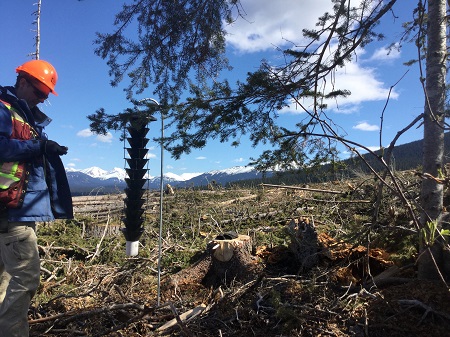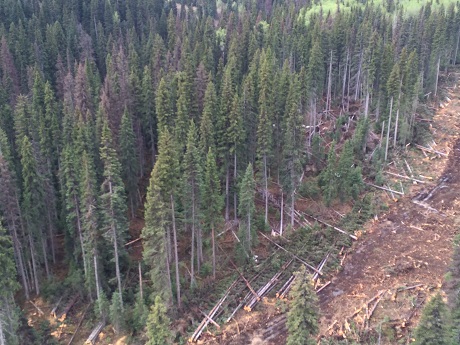Forest Health

Michael Watson, Seasonal Field Assistant, Planning, sets up beetle traps in the Anzac operating area near Prince George to monitor beetle flights throughout the summer of 2017.
For more than a decade, the mountain pine beetle has had significant impacts on forests in British Columbia and Alberta. It has largely run its course although we expect it will continue in northeast BC and Alberta for the next two to four years.
In most of our BC operations, we are winding down our large-scale mountain pine beetle salvage program that has been active for well over a decade now. As a result, most of our north-central BC operations virtually exhausted all of the dead pine timber stands that are suitable for lumber production. We are now shifting our harvest operations from a dead pine timber salvage program into a more traditional one of long-term sustainable harvesting, which includes prompt actions to combat forest health factors caused by insects, fire, wind and disease.
The trend of warmer temperatures and concomitant drought have subjected forests to additional stresses and are allowing certain forest pests to thrive. This has resulted in a large-scale outbreak of spruce beetle in northern British Columbia. Significant efforts are underway to combat the spruce beetle outbreak in discrete areas of the Prince George and Mackenzie timber supply areas.
Canfor is working collaboratively with other forest companies and with local and provincial government agencies to develop planning and harvesting tactics and strategies to arrest the spread and limit the damage caused by this pest. At this time we have sufficient capacity to handle the outbreak within our operating areas, and have offered assistance to neighbouring operators who lack the capacity to address the issue.
A variety of tactics are being deployed to mitigate the spread and impact of the spruce beetle, including aerial and ground reconnaissance, trap trees, pheromone baiting, log yard and log transportation management, sanitation harvest (focused on leading-edge attack zones) and finally salvage harvest. Canfor is also moving swiftly in ramping up its capacity to harvest steep slopes where much of the spruce beetle outbreak currently exists.
We are responding to the spruce beetle infestation through the use of a highly effective trap tree method. Large-diameter spruce trees are felled in shaded areas to mimic natural wind-throw. When spruce beetles emerge from attacked trees in spring and summer, they are attracted to these trap trees to lay eggs. The trap trees are then removed and milled prior to the emergence of the beetles in the following year. Since eggs are laid under the bark, they are destroyed at the debarking stage of the milling process.

Trap trees are set to attract spruce beetles.
In Alberta, detection surveys have indicated the rate of mountain pine beetle spread is increasing in certain areas. The largest active beetle populations are found in the west central and northwest Alberta, particularly within the Jasper National Park boundary. An accelerated harvest of susceptible pine on the Canfor Forest Management Agreement area since 2009 in conjunction with government control efforts, has helped contain the spread in this area. On the other hand, pine mortality in areas north of the Peace River, including our Canfor quota area, has been extensive and harvesting objectives are now focused on salvage rather than spread prevention.